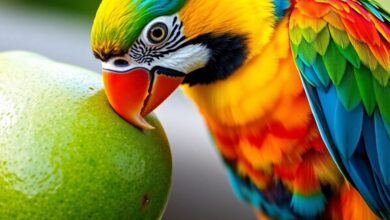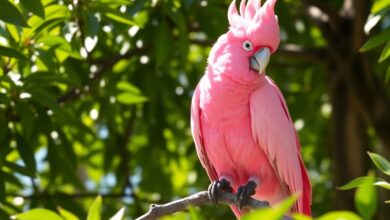How to Brood Blue Jay Eggs: Essential Tips for Success

Brooding blue jay eggs is an important part of their life cycle. Understanding their nesting habits, incubation process, and how to care for the young can help bird enthusiasts support these beautiful birds in their natural habitats. This guide will provide insights into the breeding season, nesting site preparation, and the challenges blue jays face.
Key Takeaways
- Blue jays typically lay eggs between March and July, with peak times varying by region.
- The female blue jay incubates the eggs for about 17-18 days, while the male assists by bringing food.
- After hatching, baby blue jays leave the nest in 17-21 days and are cared for by both parents.
- Blue jays usually have one brood per season, but in some areas, they may have two due to favorable conditions.
- Creating a safe environment in your backyard can help support blue jays during their nesting season.
Understanding the Blue Jay Breeding Season

When Do Blue Jays Lay Eggs?
Blue Jays typically start nesting between March and July. In warmer areas, they may begin as early as mid-March. The peak laying season in the southern regions occurs in early April, while in the northern regions, it tends to peak around mid-May.
How Many Broods Do Blue Jays Have?
Blue Jays can have one or two broods in a season, depending on their location and success in raising their young. In colder areas, they usually manage only one brood, while in warmer climates, they may successfully raise two broods before the nesting season ends in late August.
Peak Breeding Times Across Regions
The breeding season varies by region. Here’s a quick overview:
| Region | Peak Laying Time | Number of Broods |
|---|---|---|
| Southern U.S. | Early April | 2 |
| Northern U.S. | Mid-May | 1 |
| Minnesota | Late May | 1 |
| Florida | March to July | 2-3 |
Blue Jays are known for their complex social behavior, which changes throughout the breeding season.
In summary, understanding the breeding season of Blue Jays is crucial for anyone interested in observing or supporting these beautiful birds. Their nesting habits and timing can vary significantly based on their environment and regional climate.
Preparing the Nesting Site

Choosing the Right Tree
Blue jays prefer to build their nests in deciduous or coniferous trees, usually between 10 to 25 feet above the ground. They often select a tree that provides good cover from predators. Here are some ideal tree types:
- Oak
- Pine
- Maple
Materials Used in Nest Building
The construction of a blue jay nest involves various materials. They typically use:
- Twigs and branches
- Moss and lichen
- Bark strips
- Rootlets for lining
Interestingly, in urban areas, blue jays may also incorporate human-made items like paper and plastic into their nests.
Role of Male and Female in Nest Construction
Both male and female blue jays contribute to building the nest, but their roles differ:
- Female: Primarily responsible for shaping the nest and lining it with soft materials.
- Male: Gathers materials and assists in the construction process.
- Collaboration: They work together to ensure the nest is sturdy and well-hidden.
Blue jays are known for their adaptability, often using whatever materials are available to them, including items found in human environments.
This teamwork is crucial for creating a safe and comfortable environment for their future eggs and chicks.
Incubation and Hatching Process
Incubation Duties of the Female
The female Blue Jay is primarily responsible for incubating the eggs. She typically lays a clutch of four to five eggs that are bluish or light brown with brownish spots. During the incubation period, which lasts about 16 to 18 days, she will leave the nest only briefly to eat or stretch. The male often helps by bringing her food during this time.
Role of the Male During Incubation
While the female incubates, the male plays a supportive role. He may:
- Bring food to the female on the nest.
- Stand guard nearby to protect the nest from predators.
- Help keep the area around the nest safe.
Hatching Timeline and Conditions
After the incubation period, the eggs hatch, usually in late spring or early summer. The hatchlings are born naked and helpless, requiring constant care. Here’s a quick overview of the hatching process:
| Stage | Duration |
|---|---|
| Incubation Period | 16-18 days |
| Nestling Period | 17-21 days |
| Time to Fledge | 17-21 days after hatching |
The hatching process is critical for the survival of the chicks. Both parents work together to ensure the nestlings are fed and kept warm until they are ready to leave the nest.
Caring for the Nestlings
Feeding the Chicks
Blue Jay nestlings are completely dependent on their parents for food. A juicy mealworm makes for a perfect entrée, whether it’s wriggling fresh or served dried. Here are some key points about their diet:
- High Protein Needs: Nestlings require a protein-rich diet to grow strong.
- Frequent Feedings: Parents feed the chicks every 15-20 minutes during the day.
- Diverse Diet: Insects, berries, and seeds are all part of their meals.
Thermoregulation and Protection
Nestlings are born naked and helpless, making them vulnerable. The female Blue Jay plays a crucial role in keeping them warm. Here’s how:
- Brooding: The female broods the chicks to maintain their body temperature.
- Nest Security: Both parents guard the nest against predators.
- Shelter: The nest is built high in trees, providing safety from ground threats.
Development Stages of Nestlings
The growth of Blue Jay nestlings can be broken down into stages:
- Days 1-5: Completely dependent, eyes closed, and unable to regulate body temperature.
- Days 6-12: Begin to develop feathers and can open their eyes.
- Days 13-21: Ready to fledge, they start to explore the nest area.
Caring for Blue Jay nestlings is a demanding job for the parents, requiring constant attention and feeding to ensure their survival and growth.
Fledging and Post-Nesting Behavior

When Do Baby Blue Jays Leave the Nest?
Baby Blue Jays typically leave the nest when they are 17 to 21 days old. During this time, they may wander a bit before fully fledging. Here are some key points about their fledging:
- They often stay close to the nest for the first few days.
- Young jays may be seen begging for food from their parents.
- If they stray too far, they might be mistaken for abandoned.
Parental Care After Fledging
After the young Blue Jays leave the nest, parental care continues. The parents play a crucial role in their development:
- Feeding: Parents continue to provide food for at least a month.
- Protection: They help keep the fledglings safe from predators.
- Teaching: Parents guide them in finding food and avoiding dangers.
Challenges Faced by Fledglings
Fledgling Blue Jays face several challenges as they learn to survive:
- Predation: They are vulnerable to various predators.
- Weather: Harsh weather can impact their survival.
- Inexperience: Young jays may not yet know how to find food or shelter effectively.
Fledging is a critical time for Blue Jays, as they learn essential survival skills while still relying on their parents for support. Understanding their behavior can help us protect these beautiful birds.
Common Challenges and Solutions
Predation Risks
Blue Jays face various predation risks from animals like hawks, cats, and snakes. To help protect their nests, consider these strategies:
- Choose a safe location for nesting, away from open areas.
- Use natural barriers like dense foliage to hide the nest.
- Monitor the area regularly for potential threats.
Weather-Related Issues
Severe weather can impact Blue Jay nests significantly. Here are some common weather challenges:
- Heavy rain can flood nests, especially in low areas.
- Strong winds may damage nests or displace eggs.
- Cold temperatures can threaten the survival of hatchlings.
| Weather Condition | Impact on Nests | Suggested Solutions |
|---|---|---|
| Heavy Rain | Flooding | Build nests higher |
| Strong Winds | Nest Damage | Use sturdy materials |
| Cold Temperatures | Hatchling Survival | Insulate nests |
Human Interference and Mitigation
Human activities can disrupt Blue Jay nesting. Here are ways to minimize this:
- Limit outdoor noise during breeding season.
- Avoid disturbing nests if spotted.
- Educate others about the importance of protecting wildlife.
Protecting Blue Jays and their nests is crucial for their survival. By understanding the challenges they face, we can help ensure their success in our backyards.
Observing and Supporting Blue Jays in Your Backyard
Creating a Safe Environment
To attract Blue Jays to your backyard, it’s essential to provide a safe and welcoming space. Here are some tips:
- Plant native trees: Blue Jays prefer oak, pine, and other native trees for nesting.
- Avoid pesticides: Chemicals can harm Blue Jays and their food sources.
- Provide shelter: Dense shrubs and trees offer protection from predators.
Providing Food and Water
Blue Jays are known for their diverse diet. To support them, consider the following:
- Offer a variety of seeds: Peanuts, sunflower seeds, and corn are favorites.
- Install bird feeders: Use feeders that are sturdy and can hold larger seeds.
- Provide fresh water: A birdbath can attract Blue Jays, especially in hot weather.
Monitoring and Recording Nesting Activities
Observing Blue Jays can be a rewarding experience. Here’s how to do it:
- Keep a distance: Avoid disturbing their nesting sites.
- Take notes: Record behaviors, feeding habits, and interactions.
- Use binoculars: This allows you to observe without getting too close.
Blue Jays are fascinating creatures that play a vital role in the ecosystem. By supporting them, you contribute to their survival and enjoy their beauty in your backyard.
By following these steps, you can create a nurturing environment for Blue Jays and enjoy their vibrant presence in your life.
Final Thoughts on Brooding Blue Jay Eggs
In conclusion, caring for blue jay eggs is a rewarding experience that requires patience and attention. These birds typically lay their eggs from March to July, with the female taking charge of incubation. After about 18 days, the eggs hatch, and both parents work together to feed the chicks. It’s fascinating to watch as the young jays grow and eventually leave the nest after 17 to 21 days. By understanding their nesting habits and needs, you can help ensure a successful brood. Whether you’re a birdwatcher or just curious about nature, observing blue jays can be a delightful journey.
Frequently Asked Questions
When do baby blue jays leave the nest?
Baby blue jays typically leave the nest around 17 to 21 days after they hatch. A brood usually has 3 to 7 chicks, with 4 to 5 being the most common.
How many broods do blue jays have in a season?
Blue jays usually have one brood each breeding season. However, in warmer areas or suburbs, they might have two broods due to better food availability.
Do blue jays use the same nest every year?
Most blue jays build a new nest each year, but they might reuse an old one if it’s in a safe spot. They will clean and fix it up before using it again.
What do blue jay eggs look like?
Blue jay eggs are oval-shaped and can be greenish, tan, or brown. They often have speckles in shades of brown or gray.
What month do blue jays typically lay their eggs?
Blue jays usually lay their eggs between March and July. The best time for laying eggs is early April in warmer areas and mid-May in colder ones.
Where do blue jays nest in winter?
Blue jays do not usually build nests in winter. Instead, they travel in groups and find shelter in dense trees or other safe places.




